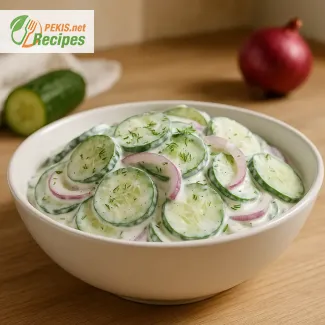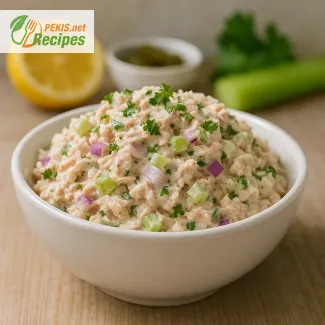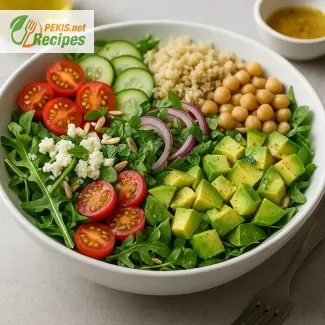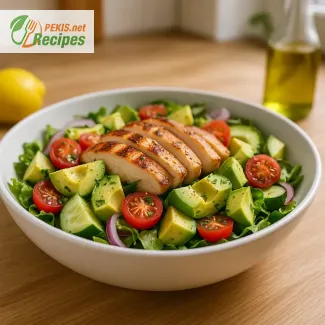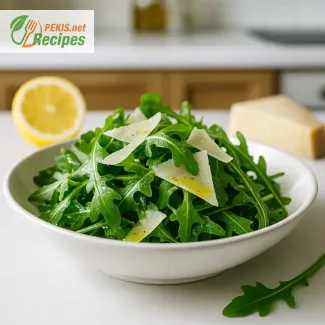
Fresh and Flavorful: A Mediterranean-Inspired Arugula Salad Experience
Discover the essence of summer with a vibrant arugula salad
A perfectly crafted arugula salad can elevate any meal from simple to sensational. With its peppery leaves, zesty lemon dressing, and the nutty depth of shaved Parmesan, this dish brings together bold yet balanced flavors in a way that’s both refreshing and satisfying. Whether served as a light starter or a vibrant side dish, this lemon arugula salad showcases the best of fresh ingredients with minimal effort and maximum flavor.
The magic of this salad lies in its simplicity. There’s no need for complicated techniques or lengthy preparation—just high-quality ingredients, thoughtfully combined to highlight their natural beauty and taste. The arugula (also known as rocket) forms the peppery base, while extra virgin olive oil provides richness and smoothness. Freshly squeezed lemon juice cuts through the oil with a bright tang, and Parmesan cheese adds a savory umami finish that ties everything together. Finished with a touch of sea salt and cracked black pepper, this salad is a tribute to the Mediterranean way of eating: wholesome, balanced, and deeply flavorful.
The role of arugula in modern cuisine
Arugula, once a humble wild green, has found its place in contemporary kitchens worldwide. It’s more than just a leafy green—it’s a flavor enhancer. With its slightly bitter undertone and mustard-like kick, arugula lends depth to dishes that need a touch of complexity. In this salad, its earthy notes contrast beautifully with the brightness of lemon and the saltiness of Parmesan, creating a truly harmonious profile.
As people look for ways to incorporate more greens into their meals, arugula salad recipes have surged in popularity. They’re not only delicious but also incredibly versatile. Whether paired with roasted vegetables, grilled meats, or enjoyed on its own, this green powerhouse holds its own on the plate. Its texture—tender yet slightly crisp—also makes it ideal for quick salads, where flavor and crunch matter equally.
Why lemon and Parmesan are perfect companions to arugula
Pairing lemon and Parmesan with arugula is a classic culinary move rooted in balance. Lemon brings acidity and freshness, brightening up the bitterness of the greens. The juice penetrates the leaves just enough to soften them slightly, while the zest, if added, amplifies the citrus aroma and sharpens the flavor. Parmesan, on the other hand, provides richness and body, mellowing the lemon’s sharpness and adding a satisfying umami bite. Together, they transform arugula from a garnish into the star of the dish.
The secret to this combination’s success lies in the interaction of their distinct flavor profiles. The salt crystals in Parmesan echo the minerality of arugula, while the lemon juice refreshes the palate, making each bite feel clean and light. This balance is what keeps you coming back for forkful after forkful.
Choosing the right olive oil for the dressing
In a salad this simple, extra virgin olive oil is more than just a medium—it’s an ingredient that contributes significantly to the overall taste. Choosing the right olive oil is crucial: it should be cold-pressed, fruity, and ideally, slightly peppery to complement the arugula. Look for oils labeled “first cold press” or “unfiltered” for the best quality and flavor impact.
The role of olive oil in this arugula salad recipe is to unify. It marries the boldness of the greens with the acidity of lemon, rounds out the saltiness of Parmesan, and adds a luxurious mouthfeel that makes the dish feel complete. Even a small drizzle can dramatically enhance the flavor and give the salad its signature Mediterranean flair.
Customizing your arugula salad with simple add-ins
While the base recipe of arugula, lemon, Parmesan, and olive oil stands beautifully on its own, this salad also lends itself to endless customization. For a touch of sweetness, consider adding cherry tomatoes or sliced pears. If you’re craving more crunch, toss in a handful of toasted walnuts or pine nuts. To boost protein, grilled chicken, seared shrimp, or even a soft-boiled egg can turn this into a more substantial meal.
Each of these additions brings new textures and flavors, but they all work harmoniously with the bold profile of the base salad. That’s the beauty of working with a strong foundation—the possibilities for creativity are endless, but the dish never loses its character.
Ideal occasions to serve this arugula salad
This arugula salad with lemon and Parmesan fits effortlessly into a wide range of menus. It’s elegant enough for a dinner party, light enough for a summer lunch, and quick enough for a weeknight dinner. Serve it alongside roasted fish, grilled chicken, or a plate of antipasti. It also makes an excellent complement to pasta dishes, especially those with creamy or tomato-based sauces, where the acidity of the salad provides contrast and balance.
Because it’s so fresh and clean, this salad is also perfect for festive occasions and holiday meals. It offers a palate-cleansing interlude between rich courses and adds a vibrant green note to any spread.
The minimalist appeal of this arugula salad recipe
What makes this dish a favorite among home cooks and professional chefs alike is its minimalism. With just a handful of ingredients—each chosen for its ability to shine—the salad achieves a flavor complexity that belies its simplicity. There’s a certain elegance in restraint, and this recipe proves that fewer elements can often lead to greater impact.
Every ingredient in this salad has a purpose. There are no fillers, no unnecessary garnishes—only flavor-forward components that complement one another. This clarity of vision allows the individual notes to sing, giving you a dish that feels refined yet effortless.
- Wash the arugula leaves gently under cold water and pat dry using a clean kitchen towel or salad spinner. Remove any thick stems if needed.
- Place the arugula in a large mixing bowl.
- In a small bowl, whisk together the freshly squeezed lemon juice and extra virgin olive oil until well emulsified.
- Drizzle the lemon-olive oil dressing over the arugula leaves and toss gently with your hands or salad tongs until evenly coated.
- Shave the Parmesan cheese using a vegetable peeler and scatter it over the dressed arugula.
- Season with sea salt and freshly ground black pepper to taste.
- Gently toss one more time just before serving or serve immediately as is.
Creative Twists to Elevate Your Arugula Salad to the Next Level
Simple adjustments that transform a classic into a signature dish
The elegance of a traditional arugula salad lies in its balance of fresh, peppery greens with the richness of Parmesan cheese and the brightness of lemon juice. But even the most beloved recipes can be improved or adjusted to suit different palates, dietary needs, or seasonal availability. With a few thoughtful modifications, you can give this classic salad a personalized touch while preserving its essential flavor profile.
Adding ingredients to enrich flavor complexity
Introducing new ingredients is one of the easiest and most effective ways to enhance an arugula salad. Here are some options that pair harmoniously with the base:
- Toasted nuts: Adding walnuts, almonds, or pine nuts brings a satisfying crunch and a layer of earthy, roasted flavor. Nuts also add healthy fats that deepen the salad’s richness.
- Fresh fruits: Slices of pear, green apple, or figs offer subtle sweetness that contrasts beautifully with arugula’s bitterness. This contrast enhances the overall flavor complexity without overpowering the core ingredients.
- Cherry tomatoes: For a more vibrant bite, halved cherry tomatoes introduce a juicy, mildly acidic component that complements the lemon juice.
- Avocado: Creamy avocado pieces add smooth texture and healthy fats, making the salad more filling and velvety in the mouth.
Each of these additions must be measured carefully—not only in quantity but also in balance. The goal is to enhance rather than mask the core ingredients.
Experimenting with cheese variations
While Parmesan is a classic choice, there are excellent alternatives that can either soften or amplify the salad’s character:
- Pecorino Romano offers a saltier, sharper profile, ideal if you want a bolder cheese component.
- Goat cheese adds creaminess and tang, transforming the salad into something softer and more delicate.
- Blue cheese brings assertiveness and richness, best used in moderation to avoid overwhelming the subtle lemon notes.
These alternatives change not just the flavor, but also the mouthfeel and finish of the dish. Choose depending on whether you want a more luxurious texture or a sharper contrast.
Dressing enhancements and healthy swaps
The standard lemon and olive oil dressing is beloved for a reason, but there’s room for subtle improvements:
- Add a small amount of Dijon mustard to emulsify the dressing and introduce a gentle tang.
- Mix in a touch of honey or maple syrup to balance out acidity and enhance the sweet-savory interplay.
- Use balsamic vinegar instead of lemon for a more robust, deeper flavor—especially good during colder months.
If you're looking for a healthier version, consider:
- Reducing the amount of cheese and adding nutritional yeast for a cheesy flavor with less sodium and fat.
- Swapping standard olive oil with flaxseed oil or walnut oil to increase omega-3 intake.
- Incorporating a spoonful of plain Greek yogurt in the dressing for added creaminess and protein.
Why homemade always tastes better
There’s a distinct advantage to preparing this dish at home. Freshness is key: pre-packaged salads often suffer from limp leaves and bland dressings, while a homemade arugula salad can be tailored in both texture and flavor intensity. You control:
- The quality of ingredients (choosing organic greens, aged cheese, fresh citrus).
- The level of seasoning (adjusting salt and acidity to your liking).
- The timing (dressing the salad just before serving preserves crispness).
Homemade versions are also more likely to be free from preservatives and excess sodium, which are common in store-bought dressings.
Mistakes to avoid when making arugula salad
Even the simplest recipes come with potential pitfalls. To ensure the best possible result, avoid these common mistakes:
- Overdressing the leaves: Arugula is delicate and can become soggy quickly. Always add the dressing gradually and toss gently.
- Using bland olive oil: The oil should be fresh and fragrant. Low-quality oil can flatten the entire dish.
- Skipping the seasoning: A pinch of sea salt and fresh black pepper enhances all other flavors. Don’t forget it.
- Storing dressed salad: Once dressed, the leaves wilt rapidly. Dress just before serving.
Seasonal variations to suit the time of year
This salad is incredibly adaptable to the seasons. In summer, use grilled peaches or watermelon to add juicy contrast. In autumn, include roasted butternut squash or caramelized onions for warmth and depth. Even in winter, citrus segments like blood oranges or grapefruit can provide a bright lift.
These variations not only follow seasonal availability but also match the mood and appetite of the season, making the salad feel new and exciting year-round.
Nutritional and gourmet advantages of customization
Customizing the arugula salad isn’t just about flavor—it’s also a pathway to nutritional enrichment. By swapping or adding ingredients, you can increase:
- Fiber (with additions like chickpeas, lentils, or whole grains)
- Antioxidants (with colorful vegetables or berries)
- Healthy fats (from avocados, nuts, or seeds)
- Protein (with lean meats, legumes, or cheese alternatives)
At the same time, you can reduce elements like sodium, saturated fat, or cholesterol by choosing lighter options without compromising taste.
Allergens present:
- Milk (from Parmesan cheese)
- None of the ingredients contain gluten
Substitution tips to eliminate allergens and gluten:
- Replace Parmesan with a dairy-free hard cheese alternative (plant-based) to make the recipe dairy-free.
- No gluten-containing ingredients are used, so no substitution is needed for gluten.
- Vitamin K: 70 mcg – supports blood clotting and bone metabolism
- Vitamin A: 950 IU – essential for vision and immune system health
- Vitamin C: 9 mg – contributes to collagen formation and antioxidant protection
- Calcium: 110 mg – important for bone health and muscle function
- Iron: 1.3 mg – helps in oxygen transport in the blood
- Potassium: 270 mg – regulates fluid balance and nerve signals
- Beta-carotene: 1,200 mcg – supports cellular health and reduces oxidative stress
- Lutein + Zeaxanthin: 1.8 mg – promotes eye health and protects against blue light damage
- Polyphenols (from olive oil): ~25 mg – reduce inflammation and improve cardiovascular health
- Vitamin E: 1.1 mg – protects cells from oxidative damage and supports immune function

